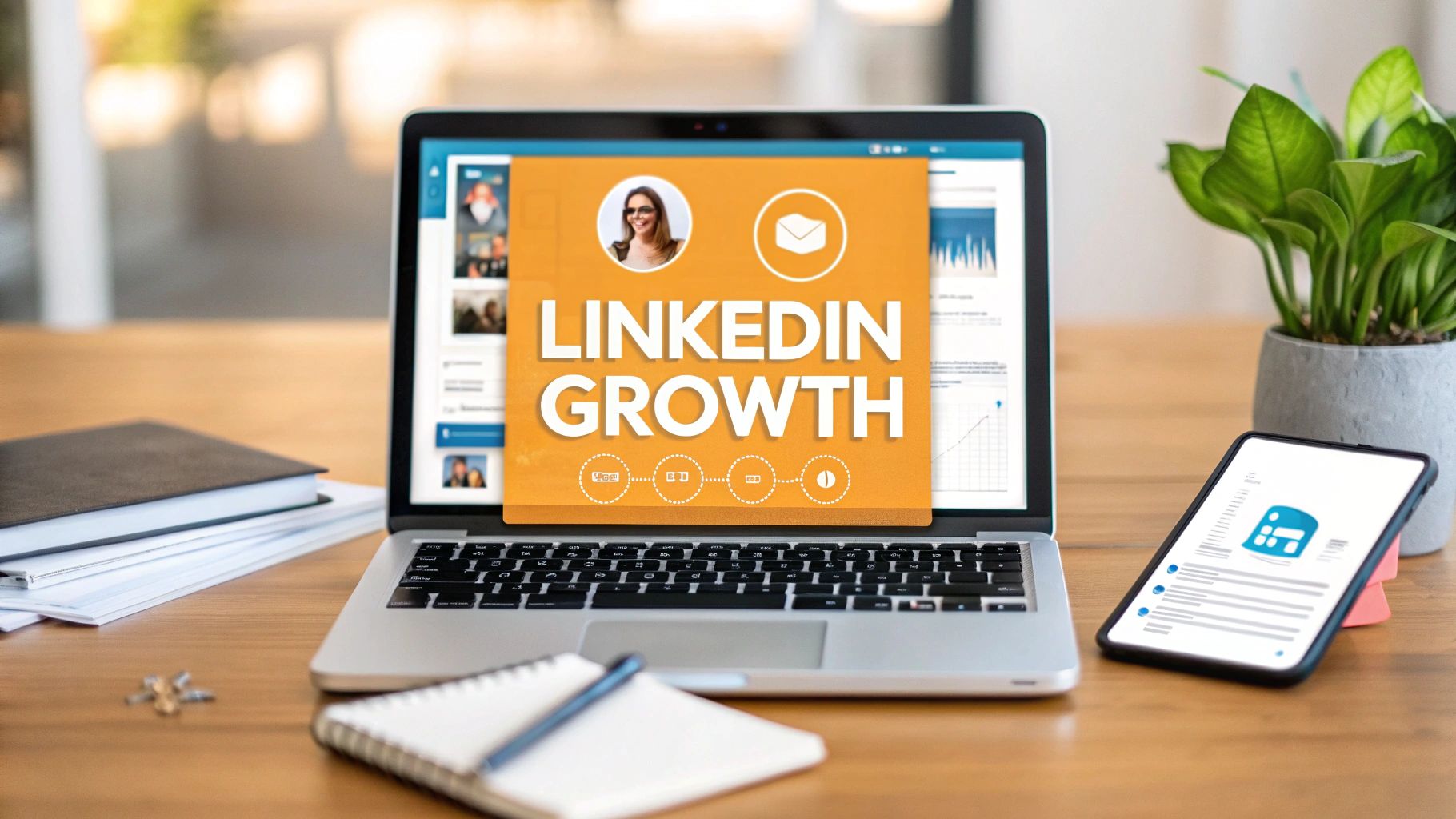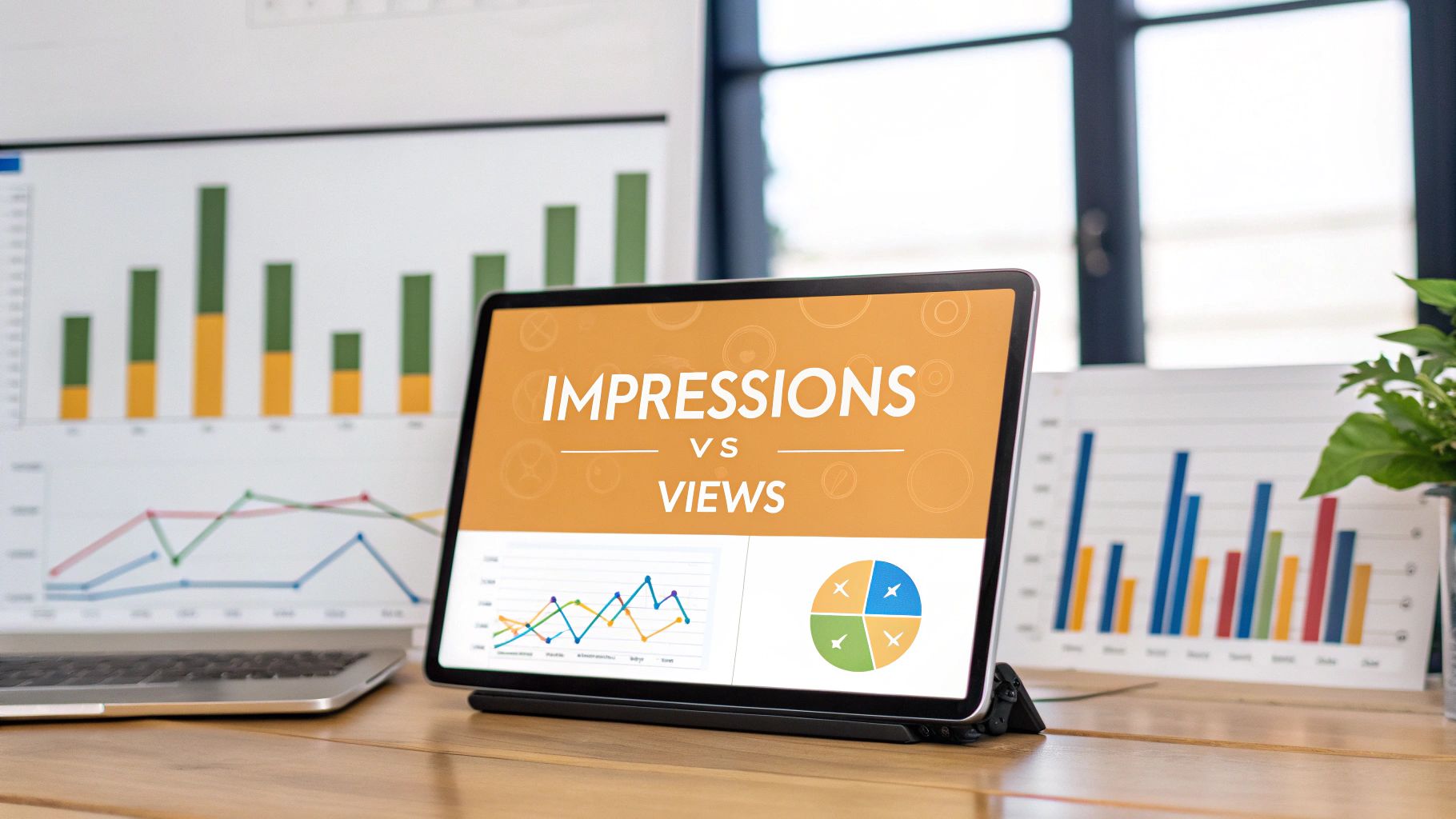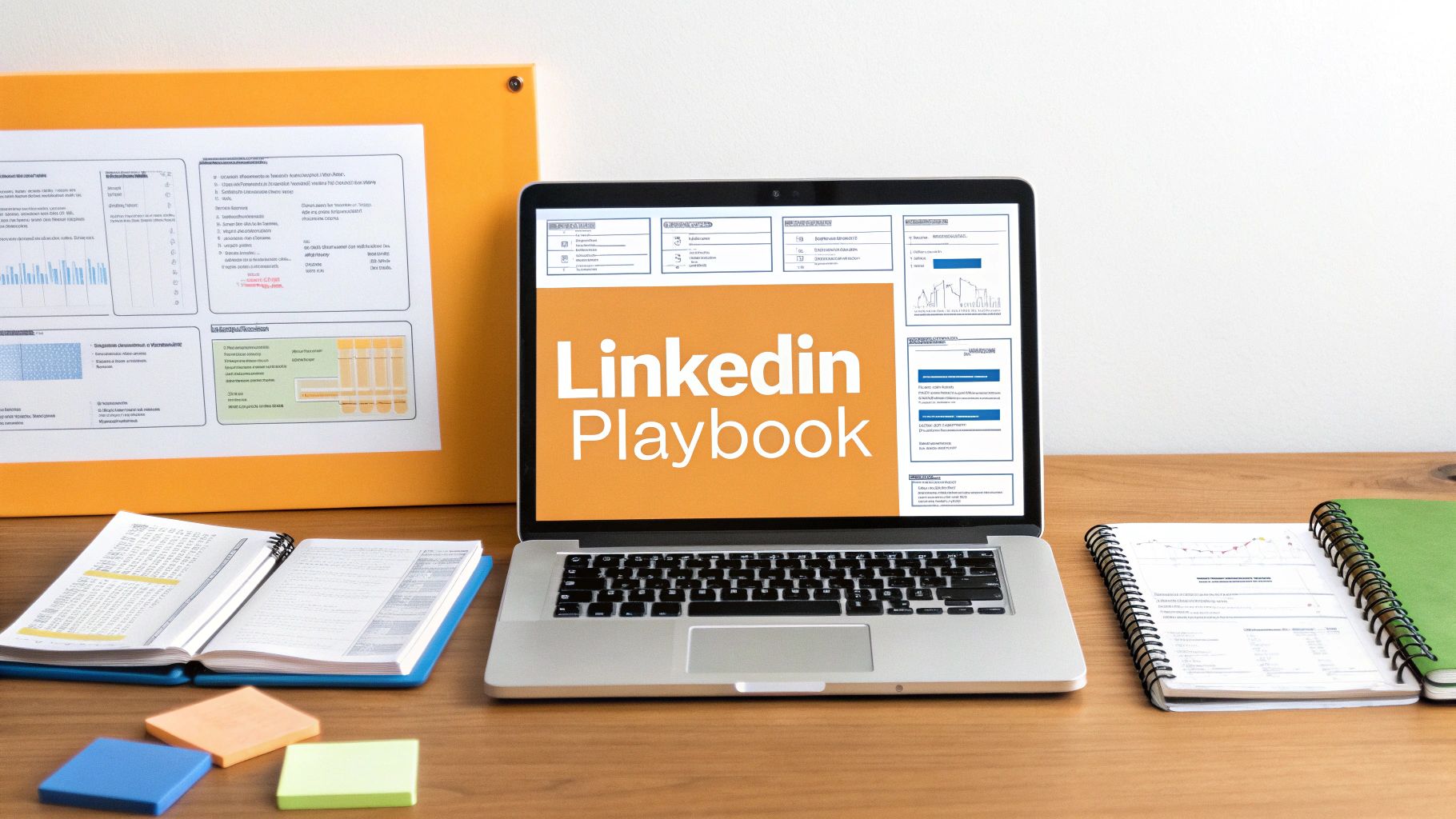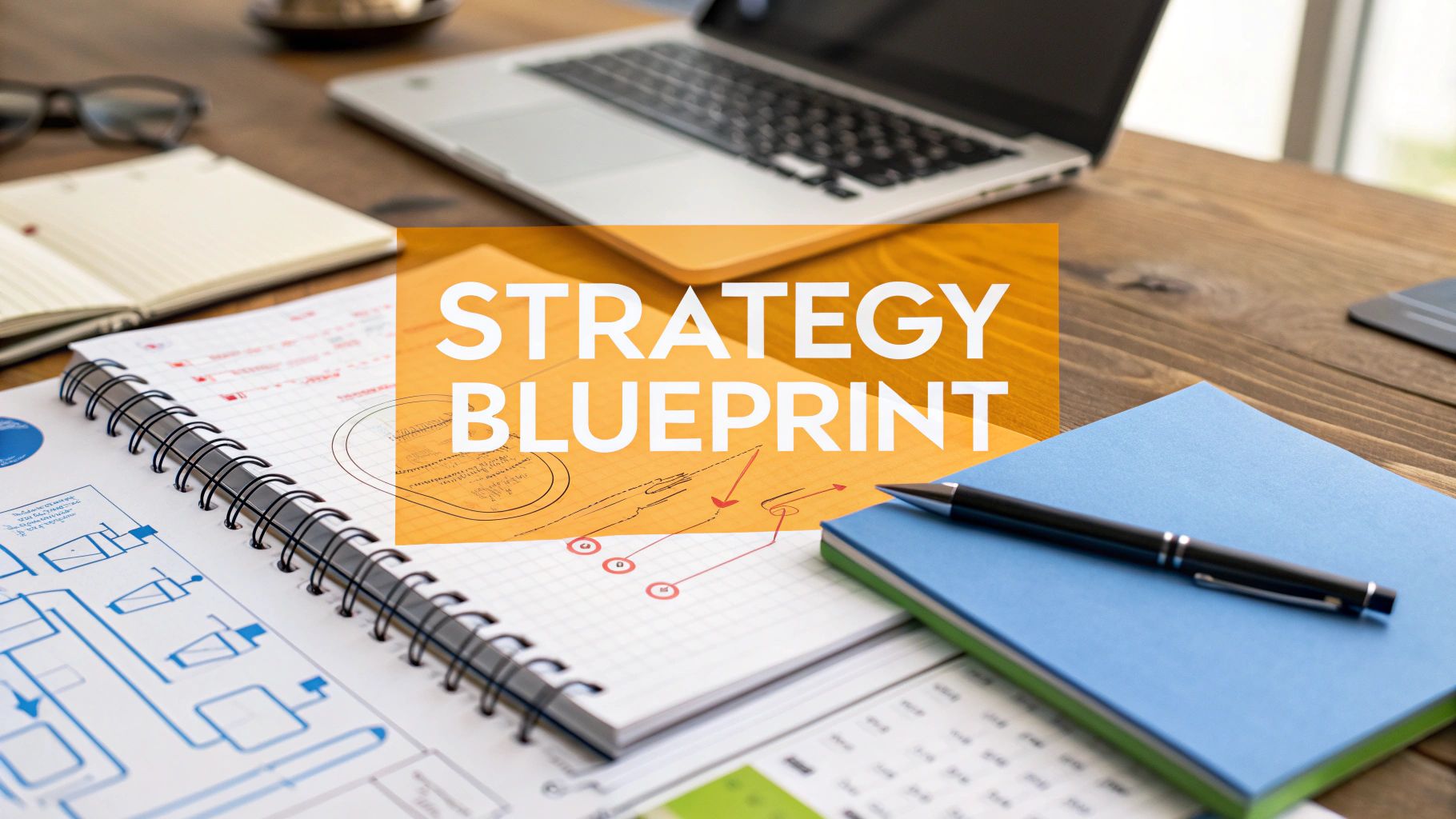In 2025, what people find when they Google your name isn't just a search result—it's your resume, your business card, and your first handshake all rolled into one. Whether you're a CEO, a freelancer, or a rising star in your field, your online reputation is a critical asset that can open doors or quietly close them. But managing this digital presence often feels overwhelming. Juggling social media profiles, online reviews, and random search results can feel like a full-time job.
The good news is, it doesn't have to be a constant struggle. We've compiled 10 powerful and practical online reputation management tips that cut through the noise and deliver real results. These aren't vague theories; they are actionable steps you can start implementing today. Taking these steps is crucial because, as many experts agree, your website is your first impression and often the centerpiece of your digital identity.
This guide is designed to help you build a digital presence that truly reflects your expertise, showcases your value, and protects your brand from the unexpected. Let's dive in and take control of your online narrative.
1. Monitor Your Digital Footprint Regularly
You can't manage what you don't measure. The first rule of effective online reputation management is to know what's being said about you, your brand, or your business in real-time. This involves systematically searching for and tracking mentions across the internet, from search engine results and social media platforms to news sites and forums.

This proactive approach is your early warning system. It helps you catch negative comments, identify misinformation, or spot unauthorized use of your identity before they escalate into a full-blown crisis. Think of how influencers use monitoring to shut down fake accounts impersonating them, or how Fortune 500 crisis teams use 24/7 systems to stay ahead of public sentiment. It’s all about early detection and rapid response.
How to Get Started
Implementing a monitoring strategy is easier than it sounds. Here are some actionable online reputation management tips to begin:
- Set Up Alerts: Use tools like Google Alerts (a free starting point) to get email notifications for your name, your business name, key executives, and even common misspellings.
- Check Dashboards Weekly: While real-time alerts are crucial for urgent issues, a dedicated weekly review of your monitoring dashboard prevents overwhelm. This helps you analyze trends without getting lost in daily noise.
- Track Competitors and Keywords: Monitoring isn't just about your name. Keep tabs on key competitors and industry keywords to understand the broader conversation and identify opportunities or threats.
- Use Specialized Tools: For a deeper dive, especially into social media conversations, consider using more advanced platforms. You can explore some of the best social media analytics tools to find a solution that fits your needs.
2. Optimize Your Social Media Profiles
Your social media profiles are often the first impression someone gets when they search for you online. By creating and maintaining complete, professional profiles, you can control the narrative and ensure these positive, brand-owned assets dominate the first page of search results. This is a foundational element of proactive online reputation management.

This strategy works because search engines like Google favor established, high-authority domains like LinkedIn, Twitter, and Facebook. A well-optimized profile on these platforms can easily outrank less flattering or irrelevant content. For instance, Sheryl Sandberg’s polished LinkedIn profile ranks at the top for her name, showcasing her professional achievements and controlling her digital first impression.
How to Get Started
Optimizing your profiles is a straightforward process that pays huge dividends. Here are some actionable online reputation management tips to strengthen your social presence:
- Use a Professional Headshot: A high-quality, professional headshot used consistently across all platforms builds recognition and trust. Business leaders using professional photos see a significant increase in profile views.
- Write Keyword-Rich Bios: Craft compelling bios that include keywords related to your industry and expertise. This helps your profiles rank for relevant searches beyond just your name.
- Fill Out Every Field: Don't skip the optional sections. A complete profile appears more credible to both users and search engine algorithms. Include your website, work history, and skills.
- Verify Your Accounts: If a platform offers verification (like the blue checkmark), pursue it. Verified accounts are perceived as more authentic and trustworthy, which can boost engagement and credibility.
3. Create and Publish Quality Content Regularly
The best defense is a good offense, and in online reputation management, content is your strongest offensive play. Regularly creating and publishing high-quality, valuable content allows you to control the narrative surrounding your name or brand. By populating search results with positive, authoritative assets that you own, you can effectively push down any negative or irrelevant mentions.
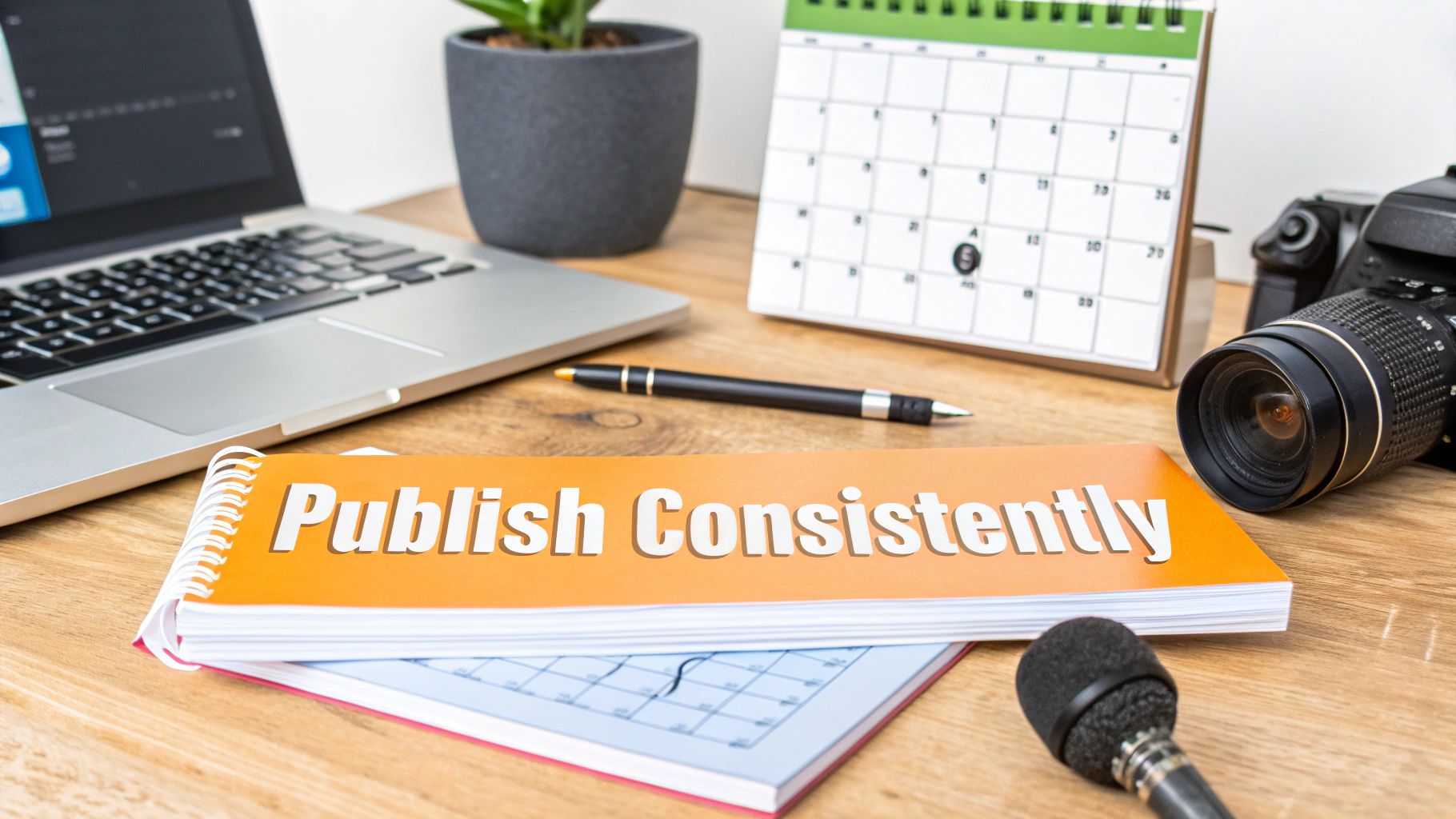
This proactive strategy builds a digital fortress of positive search results. Think of how Neil Patel dominates search for anything SEO-related through his relentless blogging, or how HubSpot built an empire on the back of its educational content. They didn't just wait for conversations to happen; they actively shaped them. This is one of the most powerful online reputation management tips because it builds long-term authority and resilience.
How to Get Started
Building a content engine is a marathon, not a sprint. Here’s how to lay the groundwork for a successful content strategy:
- Focus on Value: Your primary goal should be to solve problems for your audience. Create content that educates, informs, or entertains, and naturally weave in your expertise.
- Establish a Cadence: Consistency is key. Aim to publish at least two to four high-quality pieces of content each month, whether it's a blog post, a video, or a podcast episode.
- Optimize for Search: Use keyword research to target terms your audience is searching for. Include your name and brand naturally within the content to ensure it ranks for branded searches.
- Repurpose and Distribute: Don't just publish and pray. Turn a blog post into a video, a video into social media clips, and an article into a newsletter. Developing a solid plan is crucial, and you can learn more by exploring a comprehensive content marketing strategy guide.
4. Engage Authentically and Respond to Feedback
Your online reputation isn't a one-way broadcast; it's a conversation. Engaging authentically means actively participating in discussions about your brand by responding to comments, messages, and feedback with genuine, helpful answers. This transforms your social media profiles and review pages from static billboards into dynamic community hubs.
This approach builds trust and demonstrates that you value your audience. When people see you addressing both praise and criticism, it shows you're listening and care about their experience. Think of how Southwest Airlines handles customer issues gracefully on social media, turning potential detractors into loyal advocates. Authentic engagement is a powerful tool for mitigating negativity and showcasing your brand's human side.
How to Get Started
Building an engagement strategy is about being present, professional, and personal. Here are some actionable online reputation management tips to master it:
- Respond Promptly: Aim to acknowledge comments and messages within 24 hours. A quick, empathetic response can de-escalate a negative situation before it gains momentum.
- Acknowledge and Address Criticism: Never ignore or delete valid criticism. Acknowledge the user's point, thank them for their feedback, and explain your perspective calmly. Avoid getting defensive.
- Move Heated Debates Offline: If a conversation becomes overly hostile or requires sharing private information, offer to resolve it via direct message, email, or a phone call.
- Celebrate Positive Feedback: Publicly thank users for their kind words. This not only makes the original commenter feel valued but also amplifies positive sentiment for others to see.
5. Build a Professional Website or Portfolio
The best defense is a good offense. In online reputation management, your professional website is your ultimate offensive asset. It's the one digital space you completely own and control, acting as the authoritative, central hub for your personal brand or business. When someone searches your name, a well-optimized personal website is your best chance to claim the top search result, pushing down less desirable or irrelevant content.
This strategy puts you in the driver's seat. Instead of letting scattered social profiles or third-party mentions define you, you present a curated, professional narrative. Think of how most Fortune 500 executives have a personal site that ranks first for their name, or how freelancers with a strong portfolio site see a significant increase in client inquiries. This is a foundational pillar for any serious online reputation management strategy.
How to Get Started
Creating a professional website doesn't have to be a monumental task. Here’s how you can build a powerful digital asset:
- Secure Your Domain: Register a domain name that is your name or your business name (e.g., JaneDoe.com). This is crucial for search engine optimization.
- Create Key Pages: At a minimum, include a professional "About" page with a high-quality photo, a clear description of your services or expertise, and easy-to-find contact information.
- Add Credibility Boosters: Incorporate client testimonials, case studies, or a portfolio of your work. This social proof builds trust and authority instantly.
- Keep It Fresh with a Blog: Regularly adding content to a blog section helps with SEO and demonstrates your ongoing expertise. It's one of the most effective online reputation management tips for establishing thought leadership.
- Prioritize Professional Design: Your website’s design reflects your professionalism. Use a clean, modern template and ensure it is fully mobile-responsive, as a significant portion of traffic will come from mobile devices.
6. Request and Display Positive Reviews and Testimonials
One of the most powerful online reputation management tips is to build a strong foundation of positive feedback. Proactively asking satisfied clients, customers, and partners for reviews creates a buffer against potential negative content. This isn't just about defense; it's about building social proof that directly impacts trust and conversions.
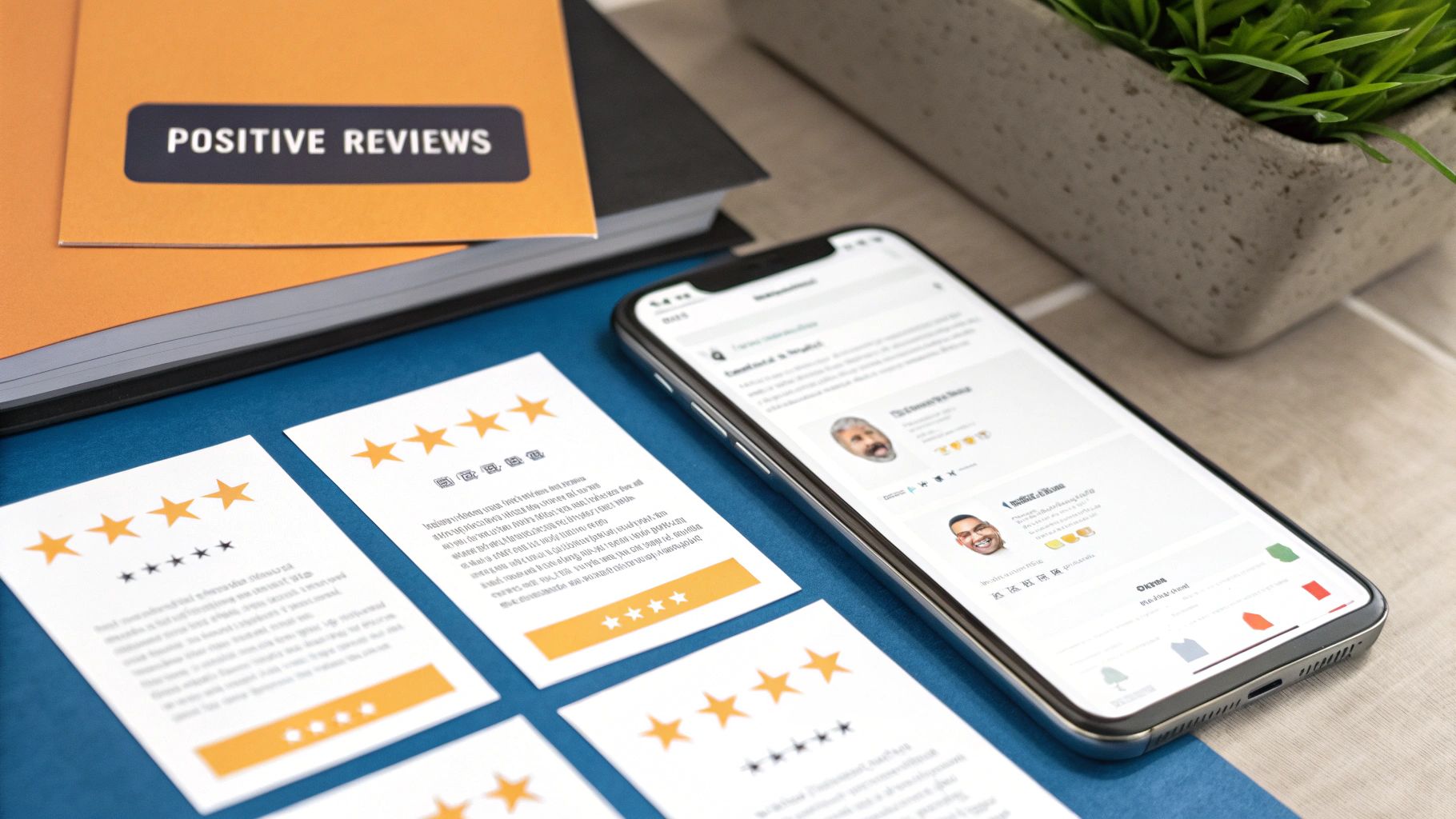
This strategy works by amplifying the voices of your happiest supporters. Think about it: a company with a 4.5-star average on Google gets far more clicks than one with no rating, and B2B SaaS companies with strong G2 or Capterra reviews often see a significant boost in sales velocity. Your goal is to make positive sentiment the most visible and accessible information about your brand.
How to Get Started
Building a collection of authentic testimonials is a straightforward process when you integrate it into your operations. Here are some actionable steps to begin:
- Time Your Ask: The best time to request a review is immediately after a positive interaction, like a successful project completion or a glowing customer service call.
- Make It Effortless: Remove all friction. Provide direct links to the specific review platforms you're targeting (e.g., Google, Trustpilot, LinkedIn) in your emails or messages.
- Automate the Request: Include a call-to-action in email signatures, on thank-you pages after a purchase, or in follow-up communications to streamline the process.
- Showcase Your Wins: Display your best reviews prominently on your website, share them on social media, and incorporate powerful quotes into your marketing materials to maximize their impact.
7. Address Negative Content Strategically
Negative content is an inevitable part of being online, but how you handle it makes all the difference. Instead of reacting emotionally or ignoring it, develop a strategic approach to manage negative reviews, articles, or social media posts. This means responding professionally, offering solutions, and proactively creating positive content to displace the negative.
A strategic response can turn a crisis into an opportunity. When Domino's faced a viral video of employees mishandling food, they didn't hide. They responded with transparent apologies, detailed their new quality control measures, and ultimately improved their brand perception. This approach demonstrates accountability and can win back customer trust far more effectively than silence or defensiveness.
How to Get Started
Implementing a strategic response plan ensures you're prepared when negativity strikes. Here are some actionable online reputation management tips for handling criticism:
- Respond Promptly and Professionally: Aim to acknowledge negative feedback within 24-48 hours. A calm, professional, and non-defensive tone is crucial, even if the criticism feels unfair.
- Offer a Solution: Don't just apologize; provide a concrete next step. Offer to take the conversation offline to a private message, email, or phone call to resolve the specific issue.
- Know When to Push Back (and When Not To): Distinguish between legitimate criticism and defamatory or false statements. For legitimate complaints, acknowledge and solve. For false attacks, you may need to request removal or pursue other options.
- Create Positive Content: The best long-term strategy is to create and promote high-quality, positive content. This helps push negative search results down, making them less visible over time. You can learn more about this by exploring how to build a personal brand that reflects your true value.
8. Leverage LinkedIn for Professional Authority
In the world of professional networking, LinkedIn is the undisputed king. It’s no longer just a digital resume; it's a powerful platform for building your personal brand and a critical component of any online reputation management strategy. When potential clients, employers, or partners search for you, your LinkedIn profile is often one of the first results they see, making it prime real estate for controlling your professional narrative.
Think of how B2B executives use the platform to generate a consistent stream of inbound leads, or how career coaches attract high-value clients simply by sharing their expertise. This isn't an accident. They are strategically shaping their reputation by establishing themselves as go-to authorities in their niche. A strong, active LinkedIn presence acts as a powerful, positive asset that can easily outrank less flattering or irrelevant search results.
How to Get Started
Building a reputable LinkedIn presence is about more than just having a profile. It's about active participation and strategic positioning. Here are some actionable tips:
- Optimize Your Profile: Go beyond a simple job title. Use a professional headshot, a custom background image, and a comprehensive headline that clearly communicates your value proposition. For a deeper dive, explore these essential tips to optimize your LinkedIn profile.
- Share Valuable Insights: Consistency is key. Aim to post original thoughts, industry analysis, or helpful content at least two to three times per week. This positions you as a thought leader, not just a passive observer.
- Engage Authentically: Don’t just post and ghost. Respond to comments on your content and leave thoughtful remarks on others' posts. Genuine engagement builds relationships and boosts your visibility in the algorithm.
- Leverage Articles: For more detailed thought leadership, consider publishing long-form content. You can learn more about how to write a LinkedIn article to effectively showcase your deep expertise and drive meaningful conversations.
9. Build and Nurture Industry Relationships and Partnerships
Your reputation isn't just about what you say; it's also about who says it for you. Building genuine relationships with industry peers, journalists, and influencers creates a network of allies who can amplify your positive reputation. These connections can lead to media mentions, speaking engagements, and collaborative projects that build your credibility organically.
This strategy works because it's based on mutual trust and value. When a respected figure in your industry mentions your work or shares your content, their endorsement carries significant weight. Think of how podcaster Tim Ferriss leverages his network of influential guests to cross-promote content, or how venture capitalists rely on their relationships to get access to the best deals and enhance their firm's prestige. It’s reputation-building through association.
How to Get Started
Cultivating these valuable connections is a long-term game that requires authenticity and a "give first" mentality. Here are some actionable online reputation management tips to begin:
- Provide Value First: Before you ask for anything, offer something. Share an influencer's content, introduce two contacts who could benefit from knowing each other, or offer your expertise on a topic without expecting anything in return.
- Attend Industry Events: Both in-person conferences and virtual summits are perfect opportunities to meet key players. Focus on making a few meaningful connections rather than collecting a stack of business cards.
- Engage Authentically Online: Participate in relevant LinkedIn groups, X (formerly Twitter) conversations, or niche forums. Offer thoughtful comments and insights, not just self-promotional links.
- Propose Collaborations: Reach out to peers with ideas for co-hosted webinars, joint research projects, or guest blog posts. A successful collaboration benefits everyone involved and strengthens your professional bond.
10. Manage Privacy Settings and Personal Information Sharing
What you don't share can't be used against you. A crucial aspect of online reputation management is controlling the flow of your personal information and locking down your digital privacy. This involves actively managing who can see your data on social media, removing your details from data broker sites, and generally being cautious about what you broadcast to the public.
This preventative strategy minimizes your attack surface. High-profile executives often implement strict privacy measures to thwart social engineering attacks, while celebrities scrub their information from data broker sites to prevent stalking. By limiting public access to your personal life, you create a stronger barrier against misinformation, harassment, and competitive intelligence gathering, ensuring your private life stays private.
How to Get Started
Taking control of your digital privacy is an ongoing process, not a one-time fix. Here are some actionable tips to begin securing your information:
- Audit Social Media Quarterly: Systematically review the privacy settings on all your social media accounts. Check who can see your posts, view your friends list, and tag you in photos.
- Remove Yourself from Data Brokers: Use services like DeleteMe or manually opt out of major data broker websites (like Whitepages and Spokeo) that collect and sell your personal information.
- Enable Two-Factor Authentication (2FA): Activate 2FA on every possible account, especially email and social media. This adds a critical layer of security that protects you even if your password is compromised.
- Be Selective with Connections: Don't automatically accept every friend or follow request. Vet new connections to ensure you aren't unknowingly giving access to someone with malicious intent.
10-Point Online Reputation Management Comparison
| Strategy | Implementation Complexity 🔄 | Resource Requirements ⚡ | Expected Outcomes ⭐ 📊 | Ideal Use Cases 💡 | Key Advantages ⭐ |
|---|---|---|---|---|---|
| Monitor Your Digital Footprint Regularly | 🔄 Medium — setup + tuning | ⚡ Tool subscriptions + regular time | ⭐⭐⭐⭐ — early detection; actionable insights 📊 | Brands, influencers, crisis-prone profiles | ⭐ Early threat detection; cross‑platform coverage |
| Optimize Your Social Media Profiles | 🔄 Low–Medium — profile SEO & branding | ⚡ Time for photos, copy; occasional design help | ⭐⭐⭐ — improved search visibility; stronger first impressions 📊 | Personal branding, job seekers, small businesses | ⭐ Consistent professional presence; narrative control |
| Create and Publish Quality Content Regularly | 🔄 High — strategy + production cadence | ⚡ Significant time, creators, SEO tools | ⭐⭐⭐⭐ — long‑term authority; improved rankings 📊 | Thought leadership, SEO recovery, domain authority | ⭐ Builds expertise; pushes down negative results |
| Engage Authentically and Respond to Feedback | 🔄 Medium–High — workflows & training | ⚡ Ongoing team time; community tools | ⭐⭐⭐ — stronger trust and retention; sentiment shift 📊 | Customer service, community-driven brands | ⭐ Converts critics; humanizes brand |
| Build a Professional Website or Portfolio | 🔄 Medium — design + SEO setup | ⚡ One‑time development + hosting costs | ⭐⭐⭐⭐ — centralized control; ranks for name searches 📊 | Freelancers, executives, anyone needing an authoritative hub | ⭐ Full narrative control; showcases best work |
| Request and Display Positive Reviews and Testimonials | 🔄 Low–Medium — process + compliance | ⚡ Review platforms + outreach time | ⭐⭐⭐⭐ — increased trust & conversions; search benefit 📊 | Local businesses, service providers, SaaS | ⭐ Social proof; higher click‑through and conversion rates |
| Address Negative Content Strategically | 🔄 High — PR/legal protocols | ⚡ PR/legal fees; dedicated response team | ⭐⭐–⭐⭐⭐ — crisis mitigation; possible content removal 📊 | Crisis response, defamation cases, major negative incidents | ⭐ Prevents escalation; demonstrates accountability |
| Leverage LinkedIn for Professional Authority | 🔄 Medium — profile + content rhythm | ⚡ Time for writing; networking efforts | ⭐⭐⭐⭐ — trusted professional visibility; qualified leads 📊 | B2B, executives, recruiters, thought leaders | ⭐ High credibility with professional audiences |
| Build and Nurture Industry Relationships and Partnerships | 🔄 High — long‑term relationship building | ⚡ Time, event travel, outreach platforms | ⭐⭐⭐⭐ — amplified reach; third‑party validation 📊 | Speakers, authors, founders, media seekers | ⭐ Exponential amplification; credible endorsements |
| Manage Privacy Settings and Personal Information Sharing | 🔄 Medium — audits + removals | ⚡ Time + privacy tools or services | ⭐⭐ — reduced exposure; lower risk of misuse 📊 | High‑profile individuals, executives, security‑conscious users | ⭐ Protects identity and family; reduces social engineering risk |
Your Reputation is a Garden, Not a Fortress
Think of your online presence less like a static fortress you build once and more like a living, breathing garden. A fortress is defensive, rigid, and built to withstand attacks. A garden, on the other hand, is dynamic. It requires consistent care, nurturing, and proactive effort to flourish. This is the modern reality of managing your digital identity, and it’s the core philosophy behind the online reputation management tips we've explored.
You can't just build a wall and hope for the best. Instead, you need to be actively planting seeds of positive content, pulling the weeds of negativity before they take root, and watering the relationships that help your reputation grow. Each tip in this guide is a different tool for your gardening kit.
From Passive Observer to Active Cultivator
The biggest shift you can make is moving from a passive stance to an active one. Don't wait for a crisis to start thinking about your online image. The work you do today lays the foundation for a resilient and authentic digital brand that works for you 24/7.
Here are the most critical takeaways to focus on as you get started:
- Consistency is Your Superpower: Regularly publishing content, engaging with your audience, and monitoring your mentions creates a powerful compounding effect. A single blog post or a handful of positive reviews are good, but a steady stream is what builds an unshakeable reputation.
- Proactive is Better Than Reactive: Building a professional website, optimizing your LinkedIn, and securing positive testimonials before you need them is a strategic advantage. This creates a buffer of positive assets that can overshadow any potential negative content that might appear.
- Authenticity Builds Trust: Your goal isn't to create a flawless, robotic persona. It's to present an authentic and professional version of yourself or your brand. Responding to feedback, both good and bad, with grace and transparency is one of the most powerful online reputation management tips because it demonstrates character.
Your Actionable Next Steps
Feeling overwhelmed? Don't be. You don't need to implement everything at once. Pick one or two strategies from this list that feel most manageable and start there.
- For a Quick Win: Dedicate 30 minutes this week to updating your LinkedIn profile and requesting two recommendations.
- For Long-Term Impact: Set up a Google Alert for your name and commit to publishing one piece of quality content each month.
Ultimately, mastering these concepts isn't just about damage control. It’s about opportunity creation. A strong online reputation opens doors to new clients, career opportunities, and valuable partnerships. It ensures that when someone searches for you, they see a reflection of the expertise, value, and integrity you bring to the table. Start tending your digital garden today; your future self will thank you for the beautiful, thriving presence you've cultivated.
As you work to control your public-facing content, it’s just as important to manage what's private. If you've ever shared sensitive information in platforms like Slack, Discord, or Teams, RedactAI can help you find and delete those old messages permanently. Protect your private digital footprint while you build your public one with RedactAI.

















